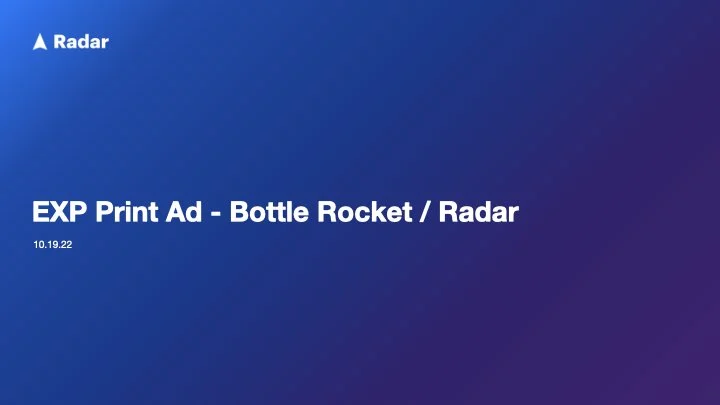Radar
Role In-house, senior designer
Industry Tech, Saas
Radar is the #1 geolocatoin platform and a global leader in scalable, secure location infrastructure. I provided graphic support to the marketing and sales teams while elevating the brand to our enterprise-level audience.
Brand strategy | Content strategy and information design | Marketing design and collateral | Event campaigns and graphics | Sales enablement | Paid search and display ads | Infographics and data visualization | Long-form content
During my first quarter at Radar, I was given the award “Raising the Bar” by the director of sales.
SETTING THE STAGE
When I began at Radar, they were still in search of a creative director to lead the full rebrand. I was tasked with elevating the existing brand to an enterprise-level, dev-targeted audience and shifting content strategy from industry-specific categories to Location-Based Marketing, Location-Aware Experiences, and Order Ahead and Pick-up through a redesign of all marketing and sales creative.
Social and paid ad redesign
Phase 1
My first project was to give the social and paid ads a deeply-needed facelift. In order to achieve a more polished feel I removed the gradient fade on Radarville, applied a zoomed-in view, and shifted to a darker background.
P1 new display ad creative
P1 new Linkedin creative
The original ad creative
Phase 2
After reviewing performance data and comparing campaigns from other SaaS companies, we determined that ads with specific, concrete statements and (usually) more general imagery were most successful. I explored the use of geometric shapes and abstract location graphics to develop two core brand styles, one developer-targeted style, and one industry-targeted style. This early exploration also helped to inform the future rebrand.
P2 general display ad creative
P2 industry-targeted display ad creative
P2 developer-focused display ad creative
Location tech print ads
Every year Bottle Rocket publishes a magazine called EXP, focused on “Experimentation.” BR invites partners to contribute content to the magazine from a list of topics, and a full-page ad placement is included with participation.
THE OBJECTIVE Drive brand awareness with creative and messaging that aligns with the awareness stage of the customer journey. At this stage, buyers know they have a problem that location might solve but have almost certainly not heard of Radar. We approached this as we would a highway billboard - general, easy to read, passively memorable, asking very little of viewers.
As a fast follow, a few more ad opportunities at events and in other publications in the logistics and retail spaces were right around the corner. So we took this opportunity to build out a full set of ads pertaining to the location technology — maximizing our impact in terms of brand awareness, consistent messaging, and overall cohesion.

THE PROBLEM
Radar wanted to become the global leader in location technology and infrastructure, and be sought after as an expert in the space by those weighing the pros and cons of adding location to their product, and whether to build or buy.
Technical Talks
THE SOLUTION The demand generation team started a bi-monthly webinar series. Each episode would feature a founder interviewing members of the Radar team, decision-makers at some of Radar’s most successful customers, and director/exec-level team members at partner companies. These topics would target both marketing and developer audiences.
Build vs buy
THE SOLUTION I coordinated with the directors of sales and business development, two account execs, marketing, and an engineer to create an asset that targeted technical audiences in late stage sales cycles, when engineers were frequently asked to weigh. We distilled a pre-existing Build vs Buy blog article with high foot traffic into a chart-heavy, cross-industry report. The layout is clean and pulled back, similar to a whitepaper, presenting the content in a straightforward and direct manner.
THE OBJECTIVE
The content marketing manager and I worked closely with sales to create quarterly assets that covered topics most useful in various stages of the sales cycle, across every industry. We perfected an intake process and templating systems that enabled us to provide every member of the every-growing team with timely, customer-specific, designed assets mid-cycle.
Sales enablement
Infographics
I crafted a content modular system in figma for one and two page infographics that targeted retail audiences at events and in early-stage sales cycles. The layouts needed to accommodate varying amounts and combinations of paragraphs and statistics, while being adaptable to other industries in the future.
Branded one pagers
I created a second content modular system in Figma for branded one pagers. Intended for events and early to mid stage sales cycles, they provide a comprehensive overview with minimal but high-impact copy.
Sales team members were instructed to:
Select a new template or a relevant completed asset, copy it into a new page, and fill out the content to the best of their ability.
Comment any visual directives and/or copy any helpful existing visuals into the project page.
The directors of sales and business development were given training in Figma at the onset of this system in order to take questions first.
A slack channel was dedicated solely for sales enablement to facilitate collaboration with design. Once steps one through three were complete, project requests were posted with relevant information regarding audience, industry, and stage of sales cycle. The agreed upon turnaround time for one pager assets was 24 hours, however a shorter time could be requested for potentially high-revenue deals.
Case studies
Easily digestible, clean, illustrated assets that break down Radar’s best customer cases into statistics that set the stage for each company’s goals, the challenges their customers faced, and the location solution. These assets would be posted on the website, shared on social channels, and could serve as supportive material in the sales cycles. They are consistent in layout and speak to both developer and marketer audiences.
THE PROBLEM
A new gated landing page design was scheduled for the end of the quarter plan. However, midway through Q3 in the midst of preparation for a number of events, the Forrester report was added to our docket. We needed the revised gated landing page design in time for the Forrester launch, however due to time constraints and conflicts with other deadlines we did not have the resources to move up the project.
Gated landing page
THE SOLUTION I split the gated landing page redesign into three strategic phases. The first round of iterations would be 80% focused on quick layouts one to two steps up from the current page while 20% planted the seeds for more drastic exploration and bigger changes later. Phase two finalized one layout for the release of the Forrester report, and phase three reimagines a completely new look and feel.
Forrester TLP Launch
THE PROBLEM Radar commissioned Forrester to conduct a study and analysis on location technology and how it can impact both digital and physical experiences for consumers. It was a large portion of the quarter’s marketing budget and we needed to coordinate a major, multi-platform launch event.
THE SOLUTION I was responsible for all creative including a gated landing page, a designed and built email in hubspot, in-line graphics highlighting important statistics for the blog release, display ads, and graphics for Linkedin. I worked closely with a developer to bring the custom-designed landing page to life.




























































